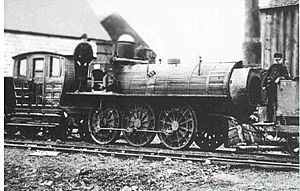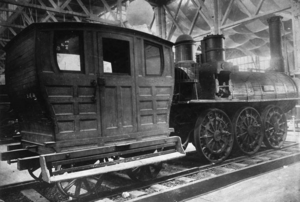Samson (locomotive) facts for kids
Quick facts for kids Samson |
|
 |
|
| Samson with its coal tender and passenger coach, The Nova Scotia Pioneer, circa 1880 | |
| Power type | Steam |
|---|---|
| Builder | Timothy Hackworth, Durham, England |
| Build date | 1838 |
| Configuration | 0-6-0 vertical cylinder |
| Gauge | 4 ft 8 1⁄2 in (1,435 mm) |
| Driver diameter | 4 ft (1.2 m) |
| Locomotive weight | 18 short tons (16 t) |
| Boiler | 540 US gallons (2,000 L; 450 imp gal) capacity |
| Cylinder size | 15 in (380 mm) bore and 16+1⁄2 in (420 mm) stroke |
| Official name | Samson |
| Delivered | May 1839 |
| First run | December 1838 |
| Retired | 1885 |
| Restored | 1893 |
| Current owner | Nova Scotia Museum of Industry, part of the Nova Scotia Museum |
| Disposition | Static display at the Nova Scotia Museum of Industry in Stellarton, Nova Scotia |
The Samson is a very old steam locomotive built in England in 1838. It used to run on the Albion Mines Railway in Nova Scotia, Canada. Today, you can see it at the Nova Scotia Museum of Industry in Stellarton, Nova Scotia. It's special because it's the oldest locomotive in Canada!
Contents
Building the Samson Locomotive
The Samson locomotive was built in 1838 by Timothy Hackworth. He built it at his Soho Works in Durham, England. The Samson was an early type of steam locomotive. It had a special boiler design. The person who added coal (the fireman) and the person who drove it (the engineer) worked on open platforms. These platforms were at opposite ends of the locomotive.
The Samson was ordered by the General Mining Association. They also ordered two other locomotives, named Hercules and John Buddle. These trains were needed for the Albion Mines Railway. This railway helped move coal from mines in Pictou County, Nova Scotia.
The Samson's Arrival in Canada
The locomotives arrived in Canada in May 1839. They came on a ship called the Ythan. The trains were not put together yet. Two engineers came with the locomotives. One was George Davidson. He helped build the trains in England. He later stayed in Nova Scotia to work with the Samson for many years.
Another person who came was John Brown Stubbs. He was a master mechanic for Timothy Hackworth. He also helped build the locomotives. After the job was done, he went back to England. The new railway officially opened on September 19, 1839, with a big party. However, the tracks to the coal pier were not finished until May 1840.
The Samson's Working Life
The Samson worked from 1839 to 1867. It carried coal on a six-mile track. This track went from the mines near Stellarton and New Glasgow to a loading pier on the East River. The Samson was a strong and dependable locomotive. Workers at the time said it was "slow but of great power."
One engineer remembered how the Samson could move many heavy coal cars. It did this even from a tricky side track on a wet day. A newer train had failed to move them. Besides moving coal, the Samson also carried passengers. It pulled an early type of passenger coach. The locomotive was mostly retired in 1867. But it still worked when needed until 1885. In 1883, it was sent to Chicago for a special railway show.
Saving the Samson

The Samson was left in a scrap yard until 1893. Then, it was shown at the Chicago World’s Fair as an old, important train. The Baltimore and Ohio Railroad bought it. They also bought one of its passenger coaches. They wanted to keep it safe.
The Samson was brought back to Nova Scotia in 1927. The passenger coach stayed behind. You can see it today at the B&O Railroad Museum. The Samson was displayed next to the Halifax train station until 1950. Then, it moved to New Glasgow.
Today, the Samson is at the Nova Scotia Museum of Industry in Stellarton. It's part of the Nova Scotia Museum. It has been carefully fixed up to look like it did at the end of its working life. Experts checked the locomotive before fixing it. They found that 90% of its original parts were still there. They also saw many repairs and changes that were added over the years. These changes were made by the Albion Mines Railway shops. A few parts, like the steel tires, were added by the B&O Railroad Museum after the Samson retired.
Why the Samson is Important
The Samson was the first locomotive in Canada to run on iron rails. It is the oldest surviving locomotive in Canada. It is also one of the oldest in North America. Plus, it is one of only three surviving locomotives designed by the engineer Timothy Hackworth. The other two are Derwent and Sans Pareil.
See also
- John Bull (locomotive)
- LMR 57 Lion
- Stourbridge Lion
- Timothy Hackworth


